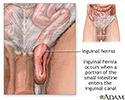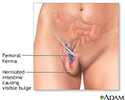Femoral hernia
Groin herniaA hernia occurs when the contents of the abdomen push through a weak point or tear in the muscle wall of the belly. This layer of muscle holds the abdominal organs in place.
Hernia
A hernia is a sac formed by the lining of the abdominal cavity (peritoneum). The sac comes through a hole or weak area in the strong layer of the be...

A femoral hernia is a bulge in the upper part of the thigh near the groin.
Causes
Most of the time, there is no clear cause of a hernia. Some hernias may be present at birth (congenital), but are not noticed until later in life.
Some factors that contribute to the development of a hernia include:
- Chronic constipation
Constipation
Constipation in infants and children means they have hard stools or have problems passing stools. A child may have pain while passing stools or may ...
 ImageRead Article Now Book Mark Article
ImageRead Article Now Book Mark Article - Chronic cough
Cough
Coughing is an important way to keep your throat and airways clear. But too much coughing may mean you have a disease or disorder. Some coughs are d...
 ImageRead Article Now Book Mark Article
ImageRead Article Now Book Mark Article - Heavy lifting
- Obesity
Obesity
Obesity means weighing more than what is healthy for a given height. Obesity is a serious, chronic disease. It can lead to other health problems, i...
 ImageRead Article Now Book Mark Article
ImageRead Article Now Book Mark Article - Straining to urinate because of an enlarged prostate
Enlarged prostate
The prostate is a gland that produces some of the fluid that carries sperm during ejaculation. The prostate gland surrounds the urethra, the tube th...
 ImageRead Article Now Book Mark Article
ImageRead Article Now Book Mark Article
Femoral hernias tend to occur more often in women than in men.
Symptoms
You may see a bulge in the upper thigh, just below the groin.
Most femoral hernias cause no symptoms. You may have some groin discomfort. It may be worse when you stand, lift heavy objects, or strain.
Sometimes, the first symptoms are:
- Sudden groin or thigh pain
- Abdominal pain
- Nausea
- Vomiting
This may mean that the intestine within the hernia is blocked. This is an emergency.
Exams and Tests
The best way to tell if there is a hernia is to have your health care provider perform a physical exam.
If there is any doubt about the exam findings, an ultrasound or CT scan may be helpful.
Ultrasound
Ultrasound uses high-frequency sound waves to make images of organs and structures inside the body.

CT scan
A computed tomography (CT) scan is an imaging method that uses x-rays to create pictures of cross-sections of the body. Related tests include:Abdomin...

Treatment
Treatment depends on the symptoms present with the hernia.
If you feel sudden pain in your groin or thigh, a piece of intestine may be stuck in the hernia. This is called an incarcerated hernia. This problem needs treatment right away in an emergency room. You may need emergency surgery.
When you have ongoing discomfort from a femoral hernia, talk to your provider about your treatment choices.
Hernias often get larger as time passes. They do not go away on their own.
Compared to other types of hernias, femoral hernias more commonly have small intestine get stuck in the weak area.
Your surgeon may recommend femoral hernia repair surgery. The surgery is done to avoid a possible medical emergency.
Femoral hernia repair surgery
Femoral hernia repair is surgery to repair a hernia near the groin in the upper thigh. A femoral hernia is tissue that bulges out of a weak spot in ...
Read Article Now Book Mark ArticleIf you do not have surgery right away:
- Increase your fiber intake and drink fluids to avoid constipation.
- Lose weight if you are overweight.
- See your provider if you have trouble urinating (men).
- Use proper lifting techniques.
Outlook (Prognosis)
The chances of a femoral hernia coming back after surgery are low.
If the intestine or other tissue becomes stuck, a portion of the intestine may need to be removed.
When to Contact a Medical Professional
Contact your provider or go to the emergency room right away if:
- You suddenly develop pain in the hernia, and the hernia cannot be pushed back into the abdomen using gentle pressure.
- You develop nausea, vomiting, or abdominal pain.
- Your hernia becomes red, purple, dark, or discolored.
Contact your provider if you have a bulge in the upper thigh next to the groin.
Prevention
It is difficult to prevent hernia. Making changes in your lifestyle can help.
References
Jeyarajah DR, Dunbar KB. Abdominal hernias and gastric volvulus. In: Feldman M, Friedman LS, Brandt LJ, eds. Sleisenger and Fordtran's Gastrointestinal and Liver Disease. 11th ed. Philadelphia, PA: Elsevier; 2021:chap 27.
Kichler K, Gomez CO, Lo Menzo E, Rosenthal RJ. Abdominal wall and abdominal cavity hernias. In: Floch MH, ed. Netter's Gastroenterology. 3rd ed. Philadelphia, PA: Elsevier; 2020:chap 48.
Poulose BK, Carbonell AM, Rosen MJ. Hernias. In: Townsend CM Jr, Beauchamp RD, Evers BM, Mattox KL, eds. Sabiston Textbook of Surgery. 21st ed. Philadelphia, PA: Elsevier; 2022:chap 45.
Reynolds JC, Ward PJ, Rose S, Solomon M. Small bowel. In: Reynolds JC, Ward PJ, Rose S, Solomon M, eds. Netter Collection of Medical Illustrations: Digestive System: Part II - Lower Digestive Tract, The. 2nd ed. Philadelphia, PA: Elsevier; 2017:31-114.
Hernia
Animation
Inguinal hernia - illustration
Inguinal hernia is the result of an organ, usually bowel, protruding through a weak point or tear in the thin muscular abdominal wall. Inguinal hernias can restrict blood supply to the bowel herniated through the defect, creating a medical emergency.
Inguinal hernia
illustration
Femoral hernia - illustration
A femoral hernia is a protrusion of a loop of the intestine through a weakened abdominal wall, located in the lower abdomen near the thigh.
Femoral hernia
illustration
Inguinal hernia - illustration
Inguinal hernia is the result of an organ, usually bowel, protruding through a weak point or tear in the thin muscular abdominal wall. Inguinal hernias can restrict blood supply to the bowel herniated through the defect, creating a medical emergency.
Inguinal hernia
illustration
Femoral hernia - illustration
A femoral hernia is a protrusion of a loop of the intestine through a weakened abdominal wall, located in the lower abdomen near the thigh.
Femoral hernia
illustration
Review Date: 8/22/2022
Reviewed By: Debra G. Wechter, MD, FACS, General Surgery Practice Specializing in Breast Cancer, Virginia Mason Medical Center, Seattle, WA. Also reviewed by David C. Dugdale, MD, Medical Director, Brenda Conaway, Editorial Director, and the A.D.A.M. Editorial team.



